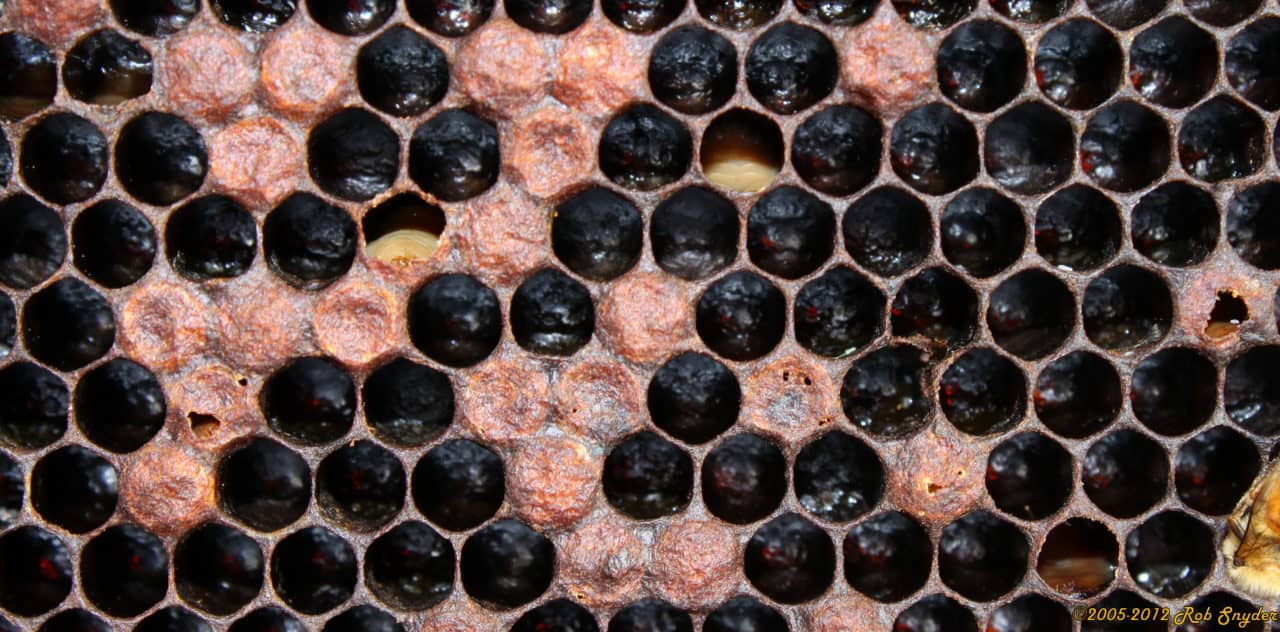SBV or Sacbrood Virus (Morator aetatulas) often appears during spring or colony buildup and causes larval death. The pupa fails to pupate and has a “shrunken head” appearance. When you see perforations in the sealed brood with the infected larvae inside, the perforation is usually choppy or jagged indicating a problem. If the SBV pupa is totally open, the capping has been completely removed by bees and the pupa is most likely greyish-yellow to brown and starting to dry out. When removed the pupa looks similar to a slipper or canoe. Infected adult bees will have decreased life spans. Symptoms: • Perforated sealed brood, pupa…
Month: October 2013
BIP Ad. November 2013
Survey Winner Announced! Scott Jaynes is our survey winner for this year. Our BIP Tech Team visited Scott in August. You can read more about the visit on our blog.
American Foulbrood (AFB)
How does AFB spread? American Foulbrood (Paenibacillus larvae) is introduced to the hive by drifting bees from nearby colonies, infected equipment/tools, beekeepers and robbing. The infection begins when spores enter the hive, and then food contaminated by spores is fed to the larvae by nurse bees. Once spores are in the midgut the bacteria take over using the larvae as a source of nourishment. After the cells are sealed, death occurs. If death occurs while in the pupal stage, there may be a protruding tongue present. When there is a serious infection you can notice moisture on sealed brood as they start to sink. Sunken…
An October Tour of the UMD Apiary
Last week, Jordan Arata and I had the pleasure of giving a tour of the UMD Apiary. The apiary is located on the roof of a]one of the campus diners. The tour was set up by Carin Cebuluski, from the UMD Arboretum; and only one person in the tour group had any beekeeping experience. I really enjoy showing people a hive for the first time, as it is always a fun experience. Jordan and I went over a few basic safety tips and equipment explanations. Then we got started. The weather was great that day and the bees were very active, buzzing around all over everyone. We went over…
Parasitic Mite Syndrome (PMS)
PMS or Parasitic Mite Syndrome is a condition that causes a honey bee colony to deteriorate and eventually dwindle away and die. There has not yet been a pathogen detected which causes the brood symptoms that appear with this syndrome. However there are always varroa mites present with this syndrome. The brood symptoms look similar to other diseases but the larvae don’t rope. Colonies with PMS will show symptoms of white larvae that are chewed or pecked down by workers. Larvae may appear sunken to the side of the cell and may show symptoms of white with some debris at the posterior end. Pupa will…
Working at the NCSU Bee Lab
Jordan Arata, one of our undergraduates who worked for our lab this summer was 'stationed' at the North Carolina State University lab working with Dr. David Tarpy. He details his experiences below. Jordan is also President of the UMD Apiary club. This summer I had the pleasure of working and learning at David Tarpy’s honey bee research facility at North Carolina State University. There, I worked alongside my friend Sam Freeze to help David Tarpy, Mike Simone-Finstrom, Jennifer Keller, and Ming Huang with various projects and experiments. One of these experiments investigated virus transmission in raising new queens. This was done by comparing the prevalence…

